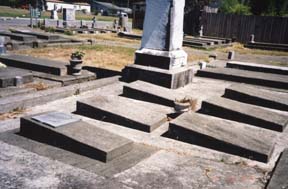|

FROM THE

COVER
STORY | IN
THE NEWS | GARDEN | GOOD NEWS | ART BEAT | CALENDAR
What
cemeteries have to tell
by KEITH EASTHOUSE
 The
heat hung heavy at the Weaverville cemetery last Sunday. High
noon in August and the sun was nothing but brutal. But a different
sort of brutality lay spread before us -- every third tombstone,
it seemed, marked the grave of a child. The
heat hung heavy at the Weaverville cemetery last Sunday. High
noon in August and the sun was nothing but brutal. But a different
sort of brutality lay spread before us -- every third tombstone,
it seemed, marked the grave of a child.
One year, six months, 17 days.
Six years, five months, 11 days. A 13-year-old girl. A 2-month-old
baby.
That is not a long life, I kept
thinking to myself. That is not a long life.
The death dates were from the
19th century, when Weaverville was a bustling mining center.
April 4, 1864. May 2, 1888. Oct. 28, 1894. June 3, 1872. "At
peace," the tombstones said. "At rest."
It's true, there was that distinctive
stillness, that graveyard hush, but whether that connoted sacredness
or nothingness I couldn't say. What I did experience were brief
visual flashes, thoughts that my imagination then formed into
mental pictures (influenced no doubt by watching too many Merchant-Ivory
productions): a mother in a high-necked dress, her face contorted
in grief; a worried father in a black tophat pacing the floor;
the doll-like visage of a baby, clad in a frilly nightgown, eyes
shut forever.
My wife and I tend to tour cemeteries
when we travel. A bit morbid, I guess. But we find it to be moving,
and somewhat grounding. It's a way to connect with past generations,
with people who really didn't live that long ago. At the same
time, it's a bit disorienting -- the world they inhabited was
so profoundly different that it almost defies comprehension.
Horses, not cars; parlor games, not television; childhood epidemics,
not worries about whether your kid is getting too much sugar.
This week, staff writer Emily
Gurnon has written about a relatively new phenomenon -- fear
of vaccines. A small but increasing number of parents in Humboldt
and elsewhere are opting not to inoculate their kids. Their reasons
include everything from fears of mercury poisoning to a belief
that the vaccines are simply no longer necessary in this day
and age. As Gurnon makes clear, that last perspective could be
a dangerous one. Diphtheria, whooping cough and other age-old
childhood scourges have been beaten back to be sure, but they
have not been eradicated. They are lurking in the shadows, and
will be, doctors' say, for the foreseeable future.
My wife and I have had our own
doubts about vaccinating our 5-year-old daughter, but we've gone
ahead and done it and feel the better for it. I'm not going to
pontificate here about what I think other parents should and
shouldn't do. But let me suggest this to parents who are grappling
with this issue. Pay a visit to an old cemetery, like the one
in Weaverville, or, closer to home, Arcata. Walk among the graves,
look at the tombstones. And then, while you're still there, take
some time to think.
PHOTO ABOVE: Deaths of children from communicable diseases were
once common in Humboldt County. This plot at St. Mary's Cemetery
in Arcata contains six child-size graves of the Silva family,
who lost seven of their 10 children around the turn of the century.
Two of them, ages 3 and 4, died of chicken pox on the same day
in 1901, county records show. Chicken pox is now a required vaccine
in California.
COVER
STORY | IN THE NEWS | GARDEN | GOOD NEWS | ART BEAT | CALENDAR
Comments?

© Copyright 2003, North Coast Journal,
Inc.
|